
Living Luxe / Summer 2018
By Kelly Merritt
Photography by Will Dickey
Through the Lens
Will Dickey chronicles Jacksonville’s natural realm with breathtaking photography of the Timucuan Preserve and other ecological gems.
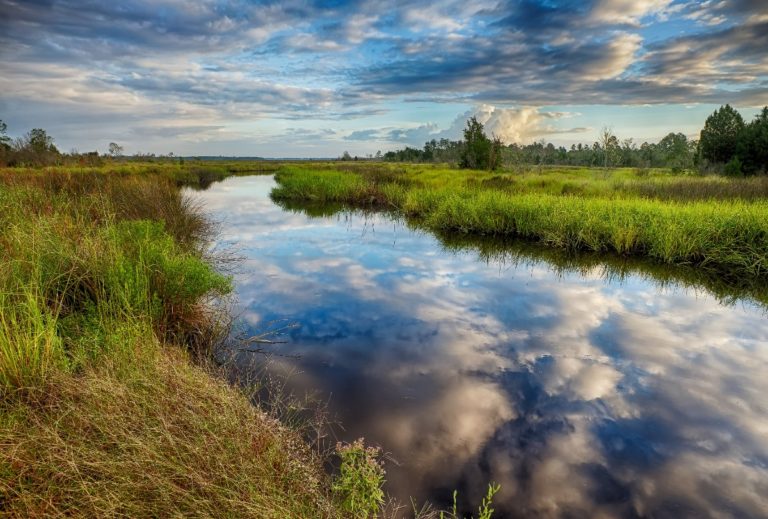
Just beyond the northern tip of what we call the “Golden Crescent,” dawn breaks over the Timucuan Ecological & Historic Preserve, casting a heavenly glow across the horizon. Grains of sand and ripples of water share a glimpse into a land seemingly untouched by man, yet just a breath away from the trappings of civilization. It is here where fine art photographer Will Dickey’s world is waking up. The hands of a different clock are at work in this vast wilderness, but on his canvas of marshland and shoreline, Dickey stops time.
By day, the award-winning photographer snaps pictures for the Florida Times–Union, where he began working early in his photojournalism career, more than three decades ago. Back then, there were 16 photographers; now there are just two.
“The way I look at it, I still get to go out and shoot photos, get paid to talk to people and tell a story through my pictures,” says Dickey, who struggled to land the coveted position in Jacksonville 34 years ago.
The Jacksonville resident may be known by the masses for photos that illustrate articles in the paper, but those who know his work can attest to why he defines our area as paradise for a nature photographer.
“Florida is quite wild, and in 20 minutes, I can be in the middle of nowhere, away from everything,” he says. “Taking photos in these environments, all seems right with the world.”
This attitude of thankfulness is one reason fans of Dickey’s photography are drawn to it. In a society where being busy is a badge of honor, each frame has a peaceful urgency, like nature itself gently pressing through his lens.
Finding an outlet in nature photography on the outskirts of Jacksonville was a soulful mission for the small–town Alabama native, who grew up fishing and hunting, going home to eat what was provided for him on the dinner table. This upbringing gave him an unparalleled appreciation for the outdoors.
“Ever since humans have recorded images, even going back to cave drawings, we have had a fascination with pictures,” says Dickey, who can’t recall a time when he wasn’t entranced by the natural environment. “The picture in your mind is fleeting, but a photo captures the moment just as it is in that time.”
It sounds easy — look, point and click — but his passion is an up-before-dawn, time-consuming process. In some instances, getting just the right shot is a matter of faith.
“When I’m out there, I just go out and whatever God gives me is what I try to summarize in the picture, because to me, it is a challenge and so very different from my editorial photojournalism work,” he says. “It is both relaxing and exciting at the same time.”
While some of Dickey’s beloved places to shoot, like St. Johns Bayard and Washington Oaks, do not reside in the Timucuan Preserve, much of his work originates in the Preserve’s 46,000–acre ecological monument to the past. A lot has changed over the years since Dickey had to quickly get the photos he needed and race back to the dark room in short intervals to make his newspaper deadline. Now, he can send pictures to the Times-Union from his car and work right up until deadline, leaving time for snapping photos of the great outdoors.
When Day Breaks Over the Timucuan
With regard to photography, Dickey is known for capturing stunning sunrises, birds, vegetation and coastal dunes. He has a way with pairing the light at dawn with a scene, while still waters have yet to churn, and he can shoot until the natural radiance runs from remarkable to mundane. Because he rises so early to capture Earth’s beauty, on his days off, Dickey’s schedule after a shoot involves returning home to cook a hearty breakfast and catch a nap.
One of his preferred early morning spots to photograph is Big Talbot Island State Park, located in the northeast sector of the Timucuan. He arrives half an hour before dawn and relishes those quiet moments when he has the expanse of the shoreline all to himself.
“Big Talbot at sunrise is deserted because so few people visit there during this time of day — it sure doesn’t look like this at noon because it is not far from Jacksonville,” he says. “A huge part of being a nature photographer is having a good alarm clock, and when it goes off, you know it’s going to be painful to get up, but you do it because you know you won’t see it otherwise.”
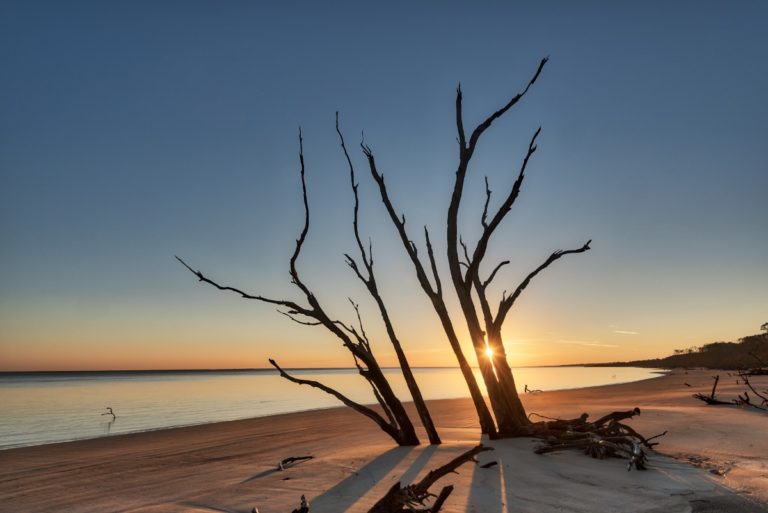
Usually Dickey can tell before the sun comes up if it will be a glorious sunrise. To him, a good landscape photo must include a center of interest, such as a meandering stream or pool of water like his shot at Little Talbot, just south of Big Talbot Island (see the opening photo of our magazine).
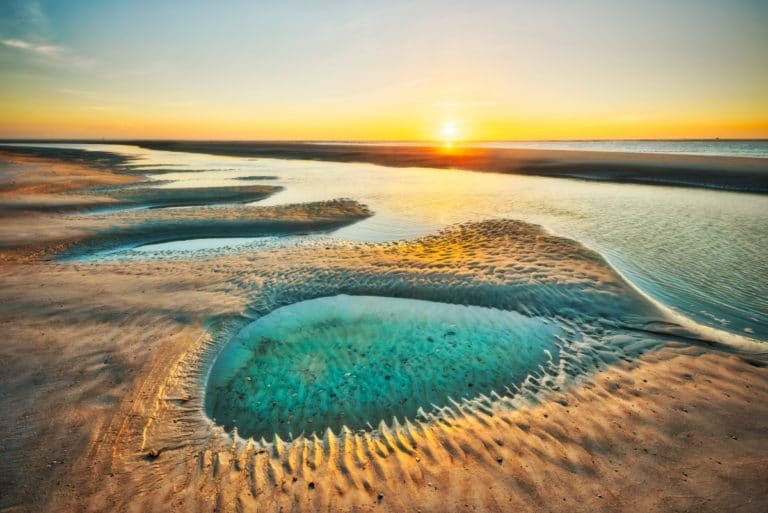
“The Hanna Park sunrise is an entirely different color palette, which I found on assignment for the paper,” says Dickey, who saw the flowers there and arranged to return to the location in the early morning. “Those beautiful dunes got washed away during Hurricane Irma, so I try to get pictures of these places while I still can.”
While Dickey doesn’t have grand ideas about what people feel about his work — he is true to the art that way — his photos often evoke a greater message. One such piece is the soothing pink and purple hued photo of dolphins just skimming the surface of the water in the Atlantic. The image is downright therapeutic, suggesting a sense of calm and assurance that everything is just as it should be.
“In the case of the two dolphins, I actually had the wrong lens on the camera — as I’m running down the beach changing the settings on the camera — and I’m not a runner. I finally caught up to them and started shooting photos like mad,” says Dickey, who fortunately came home with a couple of pictures perfectly in focus.
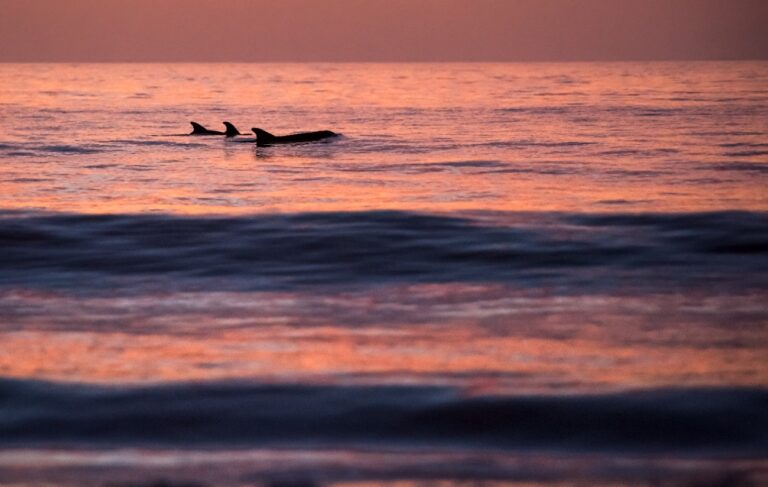
One of the most meaningful places Dickey shoots is Cedar Point, located in the heart of the Timucuan Preserve.
“You feel like you’re at the end of the earth, but it’s not that far and is the site of an old fish camp, which is closed now, but the Timucuan Foundation found a way to buy the property and put it in the Preserve,” he says. “With the cedar trees, kayakers putting their kayaks in the water, inshore anglers fishing for redfish, it’s one of my favorite spots.”
Beyond the Preserve
Another chosen spot of Dickey’s is Washington Oaks Gardens State Park where coquina rock formations have shaped its distinctive shoreline, just south of St. Augustine. His best-known photo from there is the one he calls his “happy clouds” picture, as noted on our front cover, with the clouds rolling in, escaping the thunderstorms brewing out over the ocean.
“Again, the timing is everything, and in the case of this shot, with the water spilling over the rocks, the lighting was just right,” he says. “The effect you see in that picture comes from shooting a series of photos with the camera on the tripod and bracketing the images from very dark to very light, layering the images together.”
This technical result — known as “HDR” or “High Dynamic Range” photography — is astounding detail in every inch of the photo, a full range of tonality even in the shaded areas that only the human eye can see.
Dickey heard a storm washed much of the sand away at Washington Oaks, making the rocks more visible, so that’s soon on his list of places to reshoot. If he returns with three or four good images, he’s grateful. Other times, it takes a few days and a second look to settle on which images are keepers. On occasion, Dickey admits to venturing out and returning empty-handed. That’s where he says the combination of luck and stubbornness comes into play.
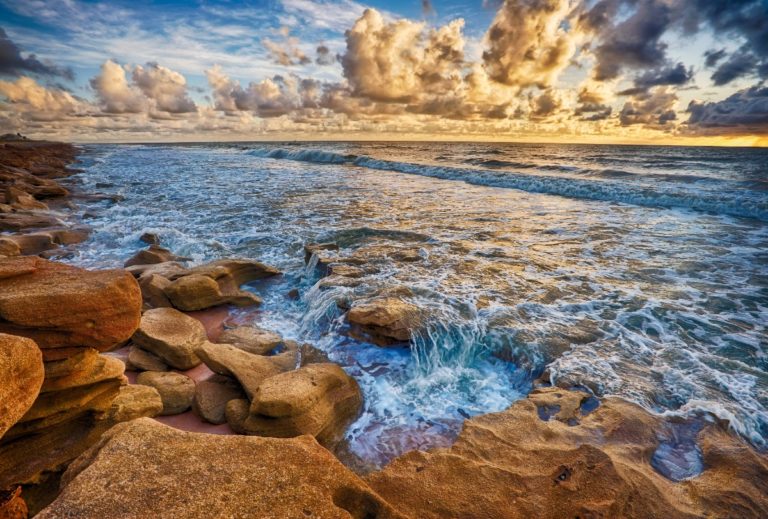
Dickey’s memories are much like his photos, rich with imagery and layers. He can recall locations in vivid aspects, even from decades ago. Sometimes those experiences come full circle. One such photo of an osprey carrying a fish in midair came about when Dickey was fishing with his youngest son on the St. Johns River.
“He was 14, so that was about 10 years ago, fishing just south of Palatka where Billy Graham preached his first sermon,” says Dickey, who got to photograph the area again after Rev. Graham passed away. “That day is why I keep a camera with a long lens at my feet at all times.”
Casting from raised platforms, trolling motor at the ready, father and son saw the osprey dive down and catch a fish. They were too far away to shoot photos of the catch, but they caught up with the fowl and its prey as it flew to a nearby tree.
“We eased up to the tree and the bird didn’t like us being there, so when it flew away, we got that shot,” says Dickey. “You just have to be ready, have a lot of luck, and I always say the universal photographer’s prayer: ‘God, please don’t let us mess this up.’”
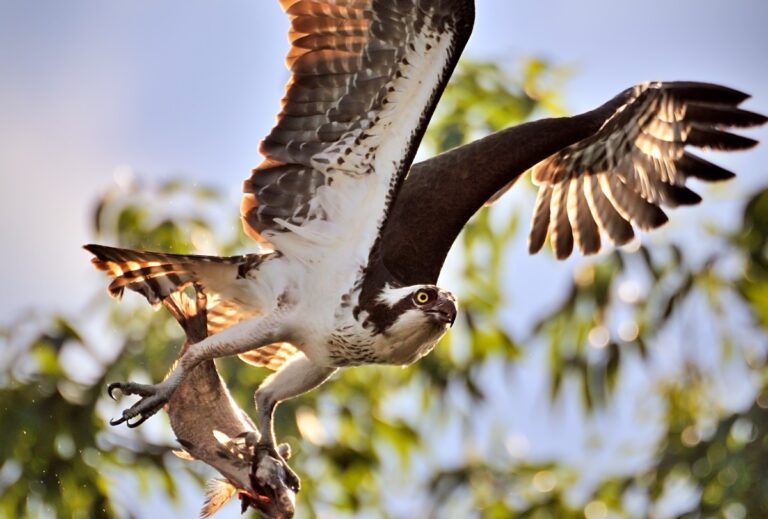
Nature photographers are born storytellers, each photo an unspoken narrative of how man sees his wild environment. Dickey knows what taking pictures can do for the human soul, how photos ground and encourage us. At 63, he remains as joyous about taking pictures as half a lifetime ago.
“I’m getting busy for my next career, which is full-time nature photography,” he says, a touch of humor in his voice.
Dickey does sell his photos, as evidenced by placement in area businesses, homes and medical facilities. As he continues his fine art photography journey, Dickey hopes to focus more on sales, including collaborating with art dealers to share his love of the region visually.
While some of Dickey’s best photos require in-depth exploring, he says many of the most beautiful images are often hidden in plain sight. First, find a place that speaks to your soul. Second, take a deep breath, point and click. willdickey.com
Plan a Fun Day at Timucuan
You won’t find tons of amenities in the Timucuan Ecological & Historic Preserve, but nature seekers will find the wild. Among the hardwood hammocks, salt marshes and sand dunes is a human history dating back 6,000 years.
A collaboration of the National Park Service, Florida Park Service and City of Jacksonville, the Timucuan offers visitors several options to explore including Cedar Point, Sisters Creek, the Talbot Islands State Parks, Kingsley Plantation and many more.
In planning a trip to the Preserve, consider your starting location, such as the visitor center at Fort Caroline National Memorial. Here, you can make an onsite plan and catch the “Where the Waters Meet” exhibit to learn more about this unique Northeast Florida habitat.
Offering a bounty of blue crab, Sisters Creek has long been the go-to destination for inshore anglers looking to ply the waters where the St. Johns River runs into the Atlantic Ocean. Tide fluctuations make it challenging to navigate the shallow salt marsh and oyster beds. Since Sisters Creek offers access for small paddle craft as well, it’s an ideal spot for kayak fishing.
For architecture buffs, the historic Kingsley Plantation is a must-see. Remnants of the tabby cabins remain, reminiscent of the days when residents baked whole oyster shells in a kiln and slaked them to make building materials.
Hikers and bikers in particular flock to Cedar Point on the southern part of Black Hammock Island. Stick to the trails and enjoy a remote stroll or bike ride through upland hammocks and marsh.
Pets are welcome on trails throughout the Theodore Roosevelt Area, provided they are on a six-foot leash for their own safety. Trails throughout the 600 acres flank an area rich in dense vegetation, hardwood forest, wetlands and more than 200 species of birds. Bring plenty of bug spray, water, and of course, your camera.
Learn more at nps.gov/timu.
